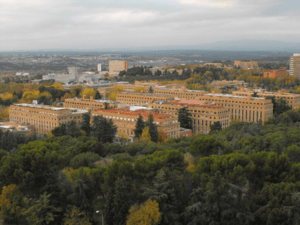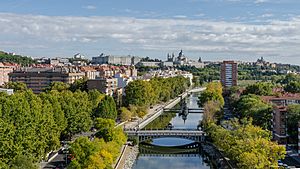Battle of Ciudad Universitaria facts for kids
Quick facts for kids Battle of Ciudad Universitaria |
|||||||
|---|---|---|---|---|---|---|---|
| Part of the Siege of Madrid of the Spanish Civil War |
|||||||
 General view of the University City. |
|||||||
|
|||||||
| Belligerents | |||||||
Durruti Column |
|||||||
| Commanders and leaders | |||||||
| Div. Gen. Francisco Franco Lt. Col. Carlos Asensio Cabanillas Lt. Col. Francisco Delgado (WIA) Lt. Col. Mohamed Meziane (WIA) |
|||||||
| Strength | |||||||
| Central Army • 11,000 International Brigades • 1,800 Durruti Column • 1,400 militiamen |
Army of Africa • 3,000 regulares • 18 light tanks |
||||||
| Casualties and losses | |||||||
| high | high | ||||||
The Battle of Ciudad Universitaria was a major fight during the Spanish Civil War. It happened in Madrid's new university area, the University City. The battle lasted about a week, from November 15 to 23, 1936. After this, the fighting lines stayed mostly the same until the war ended.
The goal for the Republican forces was to "defend the capital at all costs." They needed to stop General Valera's troops from taking Madrid. On the other side, the attackers wanted to "conquer the city" as quickly as possible. Both sides fought very hard. This battle was a turning point because it was the first time Francisco Franco's troops were stopped. The University City became one of the longest-fought areas in the war. Madrid's strong resistance also boosted the spirits of other Republican forces.
The battle ended on November 23, 1936, because the attackers changed their plan. This fight was important for several reasons. It was the first time the International Brigades fought in this war. These were volunteer soldiers from many countries. Also, heavy military equipment from the Soviet Union was used for the first time. The attackers received supplies and troops from Germany and Italy. This was also one of the first times in history that planes bombed civilians.
On November 8, 1936, General Valera's forces began their attack. They first moved towards the Casa de Campo park. The main attack then shifted northeast, aiming for the area between the University City and Plaza de España. This first attack was very bloody for both sides. The troops slowly moved through the Casa de Campo towards the Manzanares River.
The attackers needed to cross the river using bridges held by Republican forces. After several tries, they crossed the Manzanares between two bridges. The Battle of Ciudad Universitaria began on November 15. The fighting spread across the entire university campus. Both sides fought fiercely to take or defend the city. As more soldiers died, the battle became a close-quarters fight. Soldiers fought room by room, floor by floor, inside the university buildings.
After a week of intense fighting, General Franco met with his commanders. On November 23, the attackers changed their strategy. They decided to attack Madrid indirectly. They would try a move through Las Rozas-Húmera, just northeast of the campus. This led to other battles, like Jarama (February 1937) and Guadalajara (March 1937). The front line at the university stayed mostly the same for the rest of the war. Even so, there was fierce fighting with mines and counter-mines. Infantry attacks continued until March 28, 1939, when Colonel Segismundo Casado surrendered Madrid.
As a result of the battle, the University City and nearby areas were badly damaged. The university buildings were used as a war front, not for studying. It took many years for normal university activities to return. There was an idea to turn the campus into a Civil War theme park, but it never happened. The war caught the university in the middle of a big change. Many faculties were moving from the city center to the new campus. Instead of becoming places of learning, they became battlegrounds.
The reconstruction of the faculties allowed the new campus to open on October 12, 1943. Several monuments were also built to celebrate Franco's army's victory. These include the Arco de la Victoria (built 1950-1956) and the Monumento a Los Caídos Por España. The battle's scars have mostly disappeared due to reconstruction. The area has also changed with new buildings and parks like Madrid Río.
Contents
The University City: A Battleground

The University City is an area near Moncloa in Madrid. It was planned as a modern space for learning. King Alfonso XIII started this project in the early 1900s. The goal was to bring all university faculties, research labs, and student housing into one area. It was also meant to expand the education offered by the Alcalá de Henares. The University City was built on state land called La Moncloa. Construction began, and the first faculties opened on November 6, 1930. These included Medicine, Pharmacy, and Odontology. The Hospital Clínico started in 1932. Construction stopped when the Civil War began. The university was supposed to open fully in late 1936. However, social unrest and labor problems caused delays.
The University Before the Battle
In August 1936, rumors of troops advancing towards Madrid led to the suspension of university classes. Some administrative work continued, but it was limited. Professors and workers from the Central University moved to Valencia in November. It was not until November 5 that people suspected the university would become a battle zone.
Even though the campus was still being built, it had many buildings that were almost ready. From early November, the area became a long battlefield. Many buildings were badly damaged. The philosophy and letters faculty was hit the hardest. Soldiers from the International Brigades and writers shared stories of the destruction. By November 23, the attacking army occupied three-quarters of the university. For the rest of the war, many trenches, gun nests, and bunkers were built. The front lines barely moved. However, a "mine war" with tunnels and explosions completely changed the landscape.
The University City buildings were on a slight uphill slope from the Manzanares River. This meant the defending army was always at a higher position than the attackers. Only a few faculties were built: Medicine, Pharmacy, Science, and Philosophy. Also, Architecture, Veterinary, and Agrarian Engineers buildings were there. Near the Parque del Oeste were other important buildings. These included the National Sanity Institute and the Veterinary School. The Hospital Clínico was also a key building. Behind it was the main urban area of Madrid. In 1936, the area around Madrid was mostly empty plots of land. Engineers helped strengthen the defenses of the Casa de Campo, Moncloa, and the University City.
The Manzanares River and Its Bridges
The Casa de Campo was a large park surrounded by a wall. It was a private royal park until 1931. There were about ten entrances along the wall. The Manzanares River flowed between the Casa de Campo and the University City. In 1936, the riverbanks had thick plants. The river was channeled (straightened) from the Toledo bridge to the Franceses bridge. This channeled area was heavily defended and dangerous for attacking soldiers. It also made it hard for tanks to cross. Because of this, attackers avoided the channeled part. They advanced a few meters upstream from the Franceses bridge, where crossing was easier. This unchanneled river section led the battle directly to the University City on November 15, 1936. The Manzanares River, which was small in summer, had more water in autumn.
Two wide roads ran along the Manzanares River banks. The right bank road led to Castilla. The left bank road went through the Parque del Oeste. These roads were connected by several important bridges. The three bridges closest to the University City were San Fernando, the Nuevo bridge (for trains), and the Franceses bridge (for cars). Other bridges were further into Madrid. There were also several footbridges. Some bridges were built as viaducts to cross slopes. For example, the Quince Ojos viaduct carried the road to La Coruña.
See also
 In Spanish: Batalla de la Ciudad Universitaria de Madrid para niños
In Spanish: Batalla de la Ciudad Universitaria de Madrid para niños
- List of Spanish Republican military equipment of the Spanish Civil War
- List of Spanish Nationalist military equipment of the Spanish Civil War
Images for kids



